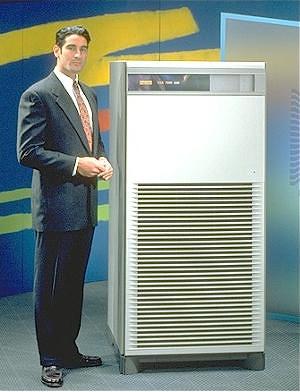 |
1992 |
 |
One of the most important goals
in the design process of the VAX 7000 was the possibility of an upgrade
to the new Alpha technology, which can be accomplished by swapping the
CPU module. Apart from this, the 7000 had some remarkable features itself:
the CPU had a clock frequency of 91 MHz, had 10 kB on-chip and 4 MB on-board
cache, while the backplane was able to deliver a throughput of 400 MB/sec!
The top models of the VAX 7000-800 series can execute up to 1795 transactions
per second.
The VAX 10000 was a big datacenter configuration of the 7000, with redundant power supplies, and a vast ammount of I/O options. |
Misc
OpenVMS AXP: A big step in the life of the VMS operating system was the introduction of VMS for the new DEC Alpha AXP platform. The OpenVMS VAX and OpenVMS AXP version were almost identical at v6.1 (from the feature-side).
End of this history page...
Digital has announced the phase-out of VAX systems in 1999, so that was the last year that a new VAX could have been ordered, allthough they stopped to make new VAX processors a few years earlier. I finish my VAX-story at the year 1992, because that was the last year when a totally new model was introduced, however, the company introduced new models until 1997...
1992 was the year of the 21064 chip, also known as the first spawn of the Alpha AXP architecture. From that point on, Digital focused on that platform, which was kind of sad, but that's business. Apart from that fact that Digital (now Compaq) is killing it off, VAX computers will be with us just like PDP-11's are still around. And hey, rumour has it that Intel has bought all the last VAXen, because the company's fab plants are controlled by VAXen, call this progression ;-)

